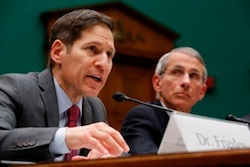The Centers for Disease Control and Prevention, hospitals and the American public were taken totally off guard by our first Ebola patient. The CDC’s reaction has been at best overly confident and at worst incompetent, cavalier and smug. Especially when you consider that we’ve known about Ebola since the 1970s, that it has killed thousands in Africa since March and that we live in a “small” world. Was it not inevitable to arrive here?
CDC Director Dr. Thomas Frieden and National Institute of Allergy and Infectious Diseases Director Dr. Anthony Fauci seem to be saying “there, there” to an understandably frightened public. And to publicly blame the two nurses (to date) who became infected by the patient, accusing them of “breaching protocol” — that takes some kind of chutzpah.
How could our response to the first Ebola patient be so botched?
• Mistake No. 1: Communication. Thomas Eric Duncan showed up in the ER at Texas Health Presbyterian Hospital in Dallas on Sept. 25 with a fever of 103 degrees, stating that he was Liberian and had recently arrived from there. His travel status did not get communicated and he was sent home with antibiotics.
Strange as it seems, I can understand how that happened. Verbal reports in hospitals have been replaced with one-way voice reports left on telephones and a reliance on the various hospital disciplines reading entries made on the electronic health record. We can’t roll back technology, but we’ve got to find a way to incorporate back into practice the irreplaceable eye-to-eye, verbal reporting of major concerns.
• Mistake No. 2: Infection control protocols that were too lax. Despite clear warnings by the World Health Organization of the epidemic’s eminent and grave dangers, the CDC did not prepare U.S. hospitals to properly screen while taking the health history of presenting patients. They also did not develop new guidelines closer to the WHO bio-containment procedures used by Doctors Without Borders, the medical charity with decades of experience fighting Ebola in Africa. Since the March outbreak, some U.S. hospitals adopted more stringent standards in training their staff, but most did not.
Therefore, with no plans in place, chaos reigned when Duncan returned to the hospital hemorrhaging copious amounts of body fluids on Sept. 28. According to Dallas Morning News reports, he waited in the waiting room for hours; a nurse supervisor’s suggestion to place him into an isolation room met with resistance from an administrator. The first three days of his stay, when the two nurses were infected, nurses wore what gear they could find: gowns that reach from the neck to mid-thigh and three pairs of gloves that were not taped at the wrist. Some were told masks and face shields were unnecessary.
Those worried that their necks were exposed used medical tape around their necks, which is not impermeable. They took off their gear by themselves with no “buddy” to watch. They went on to care for other patients without being decontaminated. In his isolation room, reportedly waste piled up to the ceiling. Blood samples for Duncan were shipped through the hospital’s pneumatic tube system. Hazmat gear wasn’t provided until the third day of his stay when Duncan’s positive ebola test was confirmed.
Late on Oct. 14, six days after Duncan died and two nurses were infected, the CDC announced new voluntary guidelines for the gear worn by hospital workers caring for Ebola patients including full-body suits covering the head and neck, supervision of the risky process of taking off protective gear, and the use of hand disinfectant as each item is removed.
I need look no further than my closet or the top of my desk to know that inertia is one of the most powerful forces for humans to overcome. The same is true for bureaucracies. As the CDC, hospitals, EMS and fire departments all over the country scramble to develop proper protocols, we will learn from the mistakes made in Dallas. More will be made, but we will get through this together.


 Austin, Texas
Austin, Texas